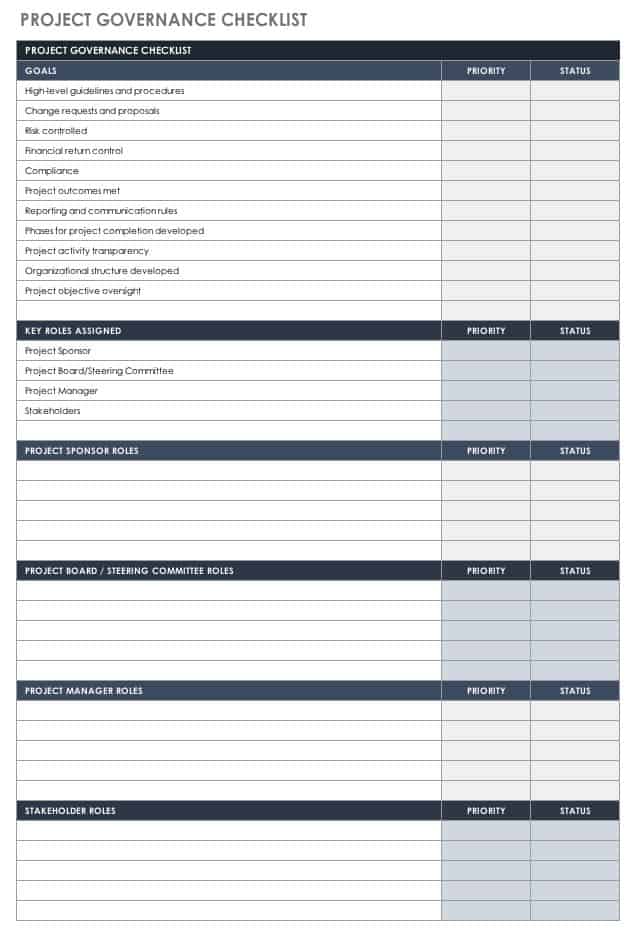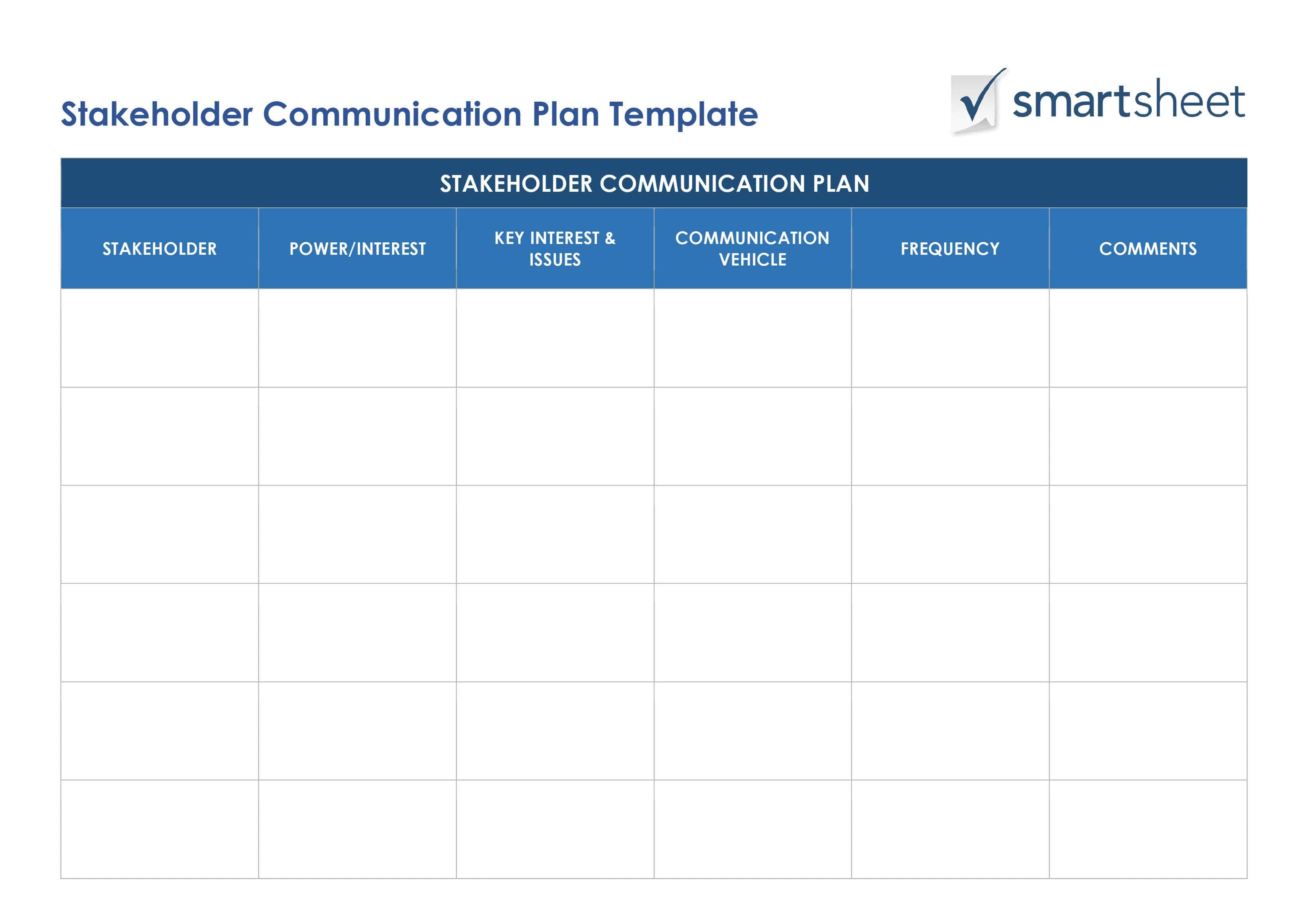What Is Project Governance?
Developed from the larger concept of corporate governance, project governance is the structured system of rules and processes that you use to administer projects. It provides a company with a decision-making framework to ensure accountability and alignment between the project team, executives, and the rest of your company. You can also apply project governance to your portfolio to govern your programs. Project governance differs from daily governance, also known as your organizational governance, since daily organizational rules and procedures cannot provide the structure necessary to successfully deliver a project. This concept is the difference between “business as usual” and “changing your business.”
Further, projects have stakeholders spread throughout an organization. Project governance should help you accomplish projects on time and on budget by bringing together these stakeholders for efficient decision-making. Project governance should also help you choose the right projects by providing the relevant structure, people, and information. The main focus should be on those key decisions that not only shape the project, but the project direction.
Since projects bring in necessary revenue for many industries, their failure or lateness can mean the difference between a company’s failure and success. It is a well-known fact in the project management industry that a high rate of projects fail. According to a 2016 study by PwC, almost 45 percent of capital projects are delayed by six or more months. Of these delayed projects, only eight percent were due to technical reasons, while the remaining 92 percent were late due to management deficiencies. This points to a lack of project governance, with deficiencies in organization, resources, oversight, planning, or unclear goals. The same applies to software projects. The 2016 Standish Group Chaos Report listed 71 percent of software project as failures.
Do not confuse good project management with good project governance, however. Many of the setbacks in a company’s projects are outside the purview of the project manager, but do lie in governance. The distinction between management and governance is in focus and intent, and it is considerable. According to the Project Management Institute (PMI), project management is all about the details. The site defines project management as “the application of knowledge, skills, tools, and techniques to project activities to meet the project requirements.” Project governance is about less about the details, and more about the conditions that set up the project and are outside the project’s boundaries. A project manager completes projects within their organization’s framework established by the governing body, (the board). This governance details the project’s needed guidance, oversight, and decision-making.
In the fields of information technology (IT) and data analytics, governance of projects is similar, but has some added elements. The projects you choose should be the right project for your company, and you should be able to support that decision. You can hire the most successful project managers available, but they will not succeed if the company does not have the right conditions in place. For IT projects, this includes IT-specific processes, such as data governance and policy review and approval. For data projects, conditions include data-specific issues such as data ownership questions, data inconsistencies, and how to use big data.
Some companies, especially large ones, have a project management office (PMO) that can support good governance by ensuring its formalization. In some smaller companies, some of the governance functions may actually come from the behest of the project manager. Although this is not ideal, there are ways to ensure that roles and responsibilities are clear and appropriate.
What Is the Governance Structure?
The governance structure is the power structure your company puts in place. Companies develop their governance structures in a multitude of ways to suit their business. Many have a tiered approach that can provide adequate accountability. Many companies also have different committees with defined roles and responsibilities. Further, some combine or share roles as per the project’s needs. Here are some of these roles in project governance:
- The Project Sponsor: Also known as the project executive, this position is responsible for providing cultural leadership, developing the business case, keeping the project aligned with the company’s strategic objectives, and directing the project manager. Stakeholders may also look to the project sponsor as a source of information.
- The Project Board: Also known as a steering committee, you charge the board with developing the project charter and ensuring that it is in compliance with the business case. The charter should provide direction for decisions that are elevated to them from the project manager, as well as approval of the overall project budget. You should set up your project board at the beginning of your project life cycle and they should operate until the project closes. All of the board members should have some stake in the project. Remember, this board is not the same as your company’s board — it only oversees a particular project. Your chair should be the most senior person responsible for the project, and include members that have a stake in the project’s outcome, such as people who can represent both the project’s users and the project’s suppliers.
- The Project Manager: This person is responsible for managing the project. The project manager performs all of the planning, initiation, execution, monitoring, and closing of a project within the confines of the business case. The person in this role should be detail-oriented and able to control the risk and accomplish the project. Project managers make many decisions, until the decision necessary violates the agreed upon business case. At that point, the project manager must elevate the decision to the board.
- The Project Stakeholders: These are the entities, whether individuals or companies (internal or external), who have an interest in or an influence on a specific project. Their influence can be positive or negative to your project outcomes, so your project manager should identify them at the outset of the project.
- The Project Management Office (PMO): Many large companies have a PMO, which provides a variety of functions within an organization. In project-based companies, the PMO supports the management much closer than in companies that have less frequent projects. Some PMOs are developed for a specific project, while others exist for multiple projects and provide support in a variety of ways.
- Senior User: This manager is responsible for the final user’s requirements and the interests of those users who will benefit from projects, especially software projects. For example, your product manager may be a good choice as your senior user, since they will be your company’s champion of the final product.
- Senior Supplier: A manager who is responsible for the product quality and the interests of the suppliers.
What is consistent across project governance is that there is no consistency. There is no one approach, mainly because it needs to be tailored to the specific company’s needs. The most important structural elements in project governance:
- It aligns with your organization’s current governance.
- It has longevity.
- It can monitor and control your project effectively.
What Is a Project Governance Framework?
It’s ideal to create a governance framework in which your projects can easily move forward and be fluid. The last thing you want is for a project to be in limbo due to bureaucracy or unnecessary scrutiny. Your governance framework should provide enough visibility and oversight so that the project board understands and manages risks quickly.
Managing projects can be a challenge — that’s why it’s imperative to have a framework at the outset. “Remember, every project and organization is different, so there is not a one-size solution that fits all situations. However, key areas that you should address are risk management and change management. This does not imply that other areas are not important,” says McGlothian. “It is just that if you have a framework for how you deal with the various risks that may arise on the project, you will develop and implement a great plan. Likewise, all projects will change during implementation. The changes will involve different stakeholders. How the project team will work with different constituents throughout the project will determine how successful the project will be. Finally, it is important to understand the ‘rules of the road’ for doing a project within the organization. This includes both the written rules as well as the unwritten rules.”
The framework should encompass structure, people, and information — but it should be the right ones, irrespective of corporate governance. Follow the steps below to develop a governance process for your next project:
Step 1: Appoint One Person Accountable for Your Project’s Success.
Assign one person who is a constant over the life of the project. This person is not the project manager, however. They should be from the business unit that the project benefits. You can identify them as either the project owner or project executive.
Step 2: Ensure Your Project Owner Is Independent of the Asset Owner.
The goal of a project is to deliver a business outcome. Asset owners are not an appropriate choice to own the project because they not only have different skill sets, but they have bias. The project owner should represent the business unit that will benefit from the project, but also have enough distance to remain unbiased. A desirable choice is the service outcome owner.
Step 3: Develop a Project Board.
The project owner needs the support of key stakeholders. These people could be the funders, users of the project’s end-product, and internal or external project suppliers. Aim to have no more than six members on the board (including the project owner) to keep the decision-making efficient. This board should manage by exception, in that they only become involved when the business case parameters are threatened, and decisions must be made.
Step 4: Ensure Separation of Stakeholder Management and Project Decision Makers. Managing your stakeholders is always a possibility. However, do not assign stakeholders as decision makers unless they are part of the board. If you have many stakeholders that want a voice, you may want to form an advisory group and have the project owner chair the group to give it legitimacy.
Step 5: Ensure Separation of Corporate Governance and Project Governance.
The project board should not have to report to the same entities as the corporate board, or to someone higher in the company. They should be able to make key project decisions that stand.
Step 6: Empower Your Project Owner.
The project owner should be involved and able to make project-related decisions. They must also own the business case (the justification for their project and its benefits).
Step 7: Develop and Maintain the Business Case.
Your business case should justify the investment and be the key governance document for the project board. Be sure to well-document the change history, and that the board assesses any changes from the original project intent. The business case should include project drivers, intended outcomes, expected benefits, the scope, the funding source, any assumptions, any interdependencies, and the schedule.
Step 8: Ensure Decision-Making Responsibilities Are Clear.
There may be many stakeholders involved, so it is critical that everyone involved in the project is keenly aware of their responsibilities. There should be no overlaps or gaps. For example, your project board approves the business case and anything that potentially changes the business case. Your project manager makes daily decisions, if they do not affect the business case. If the board and other parties own a project, create a formal agreement on the decision-making process and governance before the project kickoff, as well as a dispute resolution process.
Step 9: Documentation.
The title of this step says it all. Document everything related to governance. Be sure to include policies on project governance that define your risk-based approach, the decision rights of all parties, roles and responsibilities, and any terms.
Use this free Excel checklist for writing your own project governance plan.
How Do Governance Components Relate to The Real World?
All of the information on project governance is fine in theory, but reality is often messy, complicated, and does not allow for a one-size-fits-all approach. The following are components found in project governance and how they actually relate to the real world:
- Governance Models: Try to strike a balance when developing a governance model. The project manager (who develops this model) should aim for enough rigor to engage the stakeholders, but not so much that it is restrictive. The project scope, timeline, risks, and complexity should help the project manager create this balance.
- Accountability and Responsibilities: The project manager defines the accountability and responsibilities of the people involved in the project. Without these defined, your plan is less effective. Your meetings will be less valuable because the group will always be hashing it out, and your risk assessment and change control process will not work.
- Stakeholder Engagement: Although it seems like an exercise in futility, identifying all the stakeholders is actually a critical part of the process for understanding your project’s environment. Stakeholders can affect a project positively and negatively. If you leave out an important stakeholder, their influence can disrupt the project. Once you determine the stakeholders, the project manager will develop a communication plan.
- Stakeholder Communication: After identifying stakeholders, develop a communications plan that focuses on getting the right information to the right people in a timely way. A communication plan details how and in what way you will share necessary messages to ensure stakeholders view your project as transparent and specific.
Stakeholder Communication Plan Template - WORD
- Meeting and Reporting: This component involves striking a balance between reporting and having meetings. The information the project manager releases should ensure that all stakeholders know when and how to expect updates. They will want to know when and how they can ask questions, and how they will know the project is on track.
- Risk and Issue Management: Before a project kicks off, a real-world project manager will settle a consensus on how recognize, classify, rank, and possibly handle risks and problems. Every project has problems; preparation can help save some time and heartburn along the way. For more information on risk management, read “Project Risk Management: Best Practices, Tips, and Expert Advice.”
- Assurance: The easiest way to assure stakeholders is to provide evidence that the project is on time and on budget by sharing metrics and performance measures. It seems like a simple component, but in reality it is quite complex. The metrics provide the checks and balances in black and white. The metrics reveal any deviations and should also be delineated at the start of the project to set a baseline.
- Put exact dollar values on projects and tasks when deciding which to prioritize. That will allow you to weigh the tradeoffs between competing initiatives.
- Come up with a formula for deciding priority. For example, we use a formula for planning which features to add to our appointment reminder app. It's adapted from a spreadsheet that Baremetrics founder Josh Pigford shared that calculates "scores" based on Status, Demand, Impact, and Effort. Here's the template, called Feature Framework.
Keep in mind that it's often easy to nudge the numbers to support preconceived ideas, so be careful. Most importantly, use your best judgment after looking at quantitative and qualitative data.”
- Project Management Control Process: In the real world, this is a constant, ongoing process that leads to action in the case of deviations.
What Is Governance Framework?
Governance framework, also called governance structure, is the relationships, influences, and factors that define how you use the resources in your organization. Whether you work for a government agency or a small business, the governance framework decides how the power is wielded and managed. Good governance provides accountability. As such, a process to make the best possible decisions participates in good governance. A company can demonstrate good governance in many other ways, including the following:
- Documenting and communicating the decisions made at approval gates
- Using a lifecycle governance plan
- Ensuring the roles and responsibilities within the company structure are delineated clearly
- Showing alignment between governance and the strategic plan
- Providing oversight and adherence
- Adhering to the business case and making transparent decisions upon deviation
When two or more organizations are involved in a venture or project, good governance looks like formal agreements. All organizations should agree on these arrangements prior to their working relationship or project kickoff, and they should have the ability to re-evaluate their relationships regularly via approval gates. Other key topics in good governance include the following:
- P3 Management: These are the methods that manage projects, programs, and portfolios.
- Knowledge Management: This is how the information and data are handled in a company. Learn more about this topic by reading “Knowledge Management 101: Knowledge Management Cycle, Processes, Strategies, and Best Practices.”
- Life Cycle: This is your plan to manage your business information or project from beginning to end.
- Maturity: This is the increase of capacity or capability in a business.
- Sponsorship: This is what links corporate governance, a strategic plan, and P3 management.
- Support: Support refers to the environment for your governance managers that helps them accomplish consistency and success.
- Create a detailed structure for the project from the beginning.
- Tie in company values, priorities, and objectives to work in conjunction with the structure of the project.
- Choose a project leader, empower them, and leave them responsible for the success or failure of the project.
- Allow teams to operate autonomously as much as possible.
- Provide total clarity on decision making responsibilities within the team from the start, and adhere to it throughout the project.”
You may want to consider developing a governance information repository (GIR) for your documentation. A GIR is an accessible source of guidance documents for large or distributed companies, and shows your company that governance is important for the success of any project. A repository gives everyone, regardless of their location, immediate information on best practices and consistent guidelines. If you establish a GIR, experts recommend focusing on defining the responsible, accountable, consulted, and informed (RACI) matrix, the organizational structures, stakeholders, guidelines, and reporting needs. Store the GIR in a place that is easily accessible to your community via the internet or your intranet. Finally, experts also recommend including the ability for group communication, such as a forum for discussion. Include links to relevant documents or host templates and examples. Provide a prepackaged, adaptable toolkit for project managers to help them figure out the following:
- How much governance their project requires
- Who are their key stakeholders
- Where they can find the templates and documents they need
- Who to can contact for governance standards
What Is Governing?
Governing in business varies by organization. Whether discussing your corporation, programs, or projects, you cannot be successful without considering what makes your business unique. One key is not to confuse governance with management: Governance creates the conditions for management, and ensures that it is successful and continuous. Good governance begets good management and a lack of governance begets bad management. Understanding the difference between the two is important, especially since stakeholders have a better understanding of governance failures now.
The following are items that governance functions determine in your organization:
- Objectives
- Ethics
- Culture
- Governance Framework
- Accountability
- Compliance
Management functions include the following:
- Forecasting and Planning
- Organizing
- Leading
- Coordinating
- Controlling (Making Necessary Adjustments)
What Are Best Practices in Project Management?
It is a simple thing for a project manager, new or experienced, to look through The Guide to the Project Management Body of Knowledge (PMBOK Guide) for best practices for the field of project management. Despite being an excellent a resource, though, the PMBOK cannot offer targeted advice like your peers can. Below, find advice from project management experts.
“A key component of SEM is project portfolio management (PPM). At a high level, SEM is what you get when strategic planning, business planning, and PPM meet with actions to achieve measurable results.
I see two main issues with project governance. First, organizations often implement processes simply because a book, methodology, or consultant says they should, especially when they want to achieve some level of formal certification. But so much of it is overkill and becomes process-for-the-sake-of-process with no other real purpose. Use caution when implementing governance procedures. Make sure they add true and measurable value. Secondly, project managers rarely choose to follow disciplined approaches until they become habit.
If your company is struggling with project governance, I would say to start with the company's leadership. They have to own and communicate the initiative. Without that, project governance will go nowhere. Next, take time to interview both the project managers and the customers. Customers in this case may be internal or external, but they are the recipients of the system or product you are developing. Discover what they already do that works, their frustrations, their needs, etc. When drafting a guide, use their terms as opposed to, say, PMBOK's. Make sure you indicate what problem each process solves or what value each brings.
I would tell new project managers not to get too caught up in the theory — it all sounds great on paper. Pay more attention to what is really applicable in practice. The job of governance is to provide predictable, high quality results, not to create an administrative nightmare for those following it. Leadership has to own its implementation and insist on it, making it part of the culture as opposed to something they are going to try out in 2018. Be flexible and make modifications to it as you learn more about how it is actually working within your organization.”
Zamorano adds:
“If a company is struggling with project governance, I would begin by looking at how they bring people on their team, how they train people within the first 90 days, how well they communicate priorities, and how well they empower their managers to lead their teams. Once I have evaluated and improved those areas, I would evaluate their current project governance structure and its effectiveness, or ineffectiveness. With that information, I would work to customize a structure for each department to help bring on the right people to each team, to train them properly, and to create the necessary trust from leadership to allow their management to operate as autonomously as possible.
The key to effective project management is to have exceptional communication skills. You need to be able to communicate effectively from the beginning to understand the expectation. You need to communicate with your teammates, whether they work alongside you or report to you. And you need to be able to communicate the results produced throughout the scope of a project from beginning to end. Problem solving is at the heart of project management, and highly-effective communication is the only way to solve any kind of problem.”
“Many companies that struggle with project governance make the classic management error of trying to micromanage their way out of the bad situation. They create heavy portfolio and project governance processes. They increase the amount of non-value-added paperwork, controls, and oversight. These efforts usually have the opposite of the intended effect: Rather than improving their organizations performance, it only gets worse.
Companies wanting to improve their project and portfolio performance should develop lightweight governance processes that empowers the project and portfolio managers. Empowerment does not mean chaos. Empowerment means that the organization has the minimally sufficient level of oversight and governance needed to be successful. Empowerment means that project managers are both held accountable for their performance and given the resources and decision-making authority to be successful.”
Harrin offers the following advice:
“I've been involved in project governance from a number of angles, including as part of a project board, providing governance to a project, as a project manager, and also as someone advising and coaching other project managers through informal peer reviews.
If you feel like your company or project is struggling with project governance, the first thing to do is to remember that it's really only about oversight. The concept of project governance is to make sure that the project is doing the right things in the right way. More formal governance processes include project audits, and these are really nothing to be worried about. An audit should be constructive. The feedback is designed to help you be more successful and to help your project be more successful. No one is looking to criticize the team for not keeping adequate minutes of meetings. The whole purpose is to give your project the best possible chance of delivering the expected benefits. It’s what everyone wants.”
“To improve project governance for companies struggling, I would ask them to recognize that effective project governance must be tailored to your market, business model, and the core technologies involved. One size no longer fits all. Project governance is a tool for business success, not an end in itself. So, I would start by establishing the business problem we want to solve and by scanning what is in place. Ask:
- What has worked with your existing approaches?
- Where have they failed, specifically?
- What business impact do you want as a result of improved project governance and execution?
With respect to using processes, it very much depends on the market, product/service, and company culture within which projects are to be executed. Processes are needed, but you should craft them to serve your objectives, not in a vacuum.
I would tell new project managers that their job is to lead and to help the team succeed. One way you do that is to set up team habits that ensure you all have a current view of the project's goals, challenges, and status. Tracking tools and reports can be helpful, but it is the process and habits that make them really pay off. Another way you do that is to solicit input from your team and at times, from other stakeholders. And finally, you also do that by making decisions. Ensure your project team spends time brainstorming, evaluating status and recognizing both accomplishments and the most important next steps to take.”
Improve Project Governance with Smartsheet for Project Management
Empower your people to go above and beyond with a flexible platform designed to match the needs of your team — and adapt as those needs change.
The Smartsheet platform makes it easy to plan, capture, manage, and report on work from anywhere, helping your team be more effective and get more done. Report on key metrics and get real-time visibility into work as it happens with roll-up reports, dashboards, and automated workflows built to keep your team connected and informed.
When teams have clarity into the work getting done, there’s no telling how much more they can accomplish in the same amount of time. Try Smartsheet for free, today.








